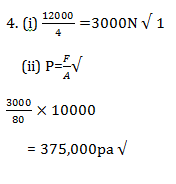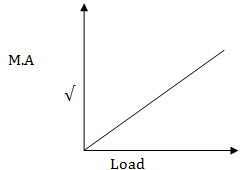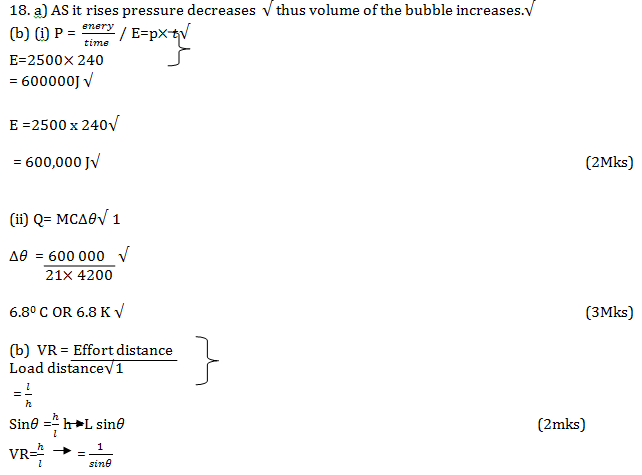SECTION A (35 Marks)
(Answer all questions in this section)
- A micrometer screw gauge has a zero error of -0.03mm. It is used to measure the diameter of a wire. If the actual diameter of the wire is 0.30mm, draw the micrometer screw gauge showing the measured diameter of the wire. (3 marks)
- The figure (1) below shows a rubber sucker, explain why the sucker sticks on a clean flat Surface. (1 mark)

- You are provided with a test – tube, thread and a meter ruler. Outline the steps you would use to measure the circumference and hence the diameter of the test – tube. (4marks)
- A car weighs 12 000N. What is the force acting on one tyre if the weight is evenly distributed amongst the tyres? (1 mark)
If the area of contact of tyre is 80cm2.Calculate the pressure of the air in the tyre. (3 marks) - Why are gases easily compressible while liquids and solids are almost incompressible?(1 mark)
- Name three properties of a clinical thermometer that make it suitable for measuring body temperature (3 marks)
- How does the volume of a given mass of water change as;
- The water is cooled from 100 C to 00C? (1 mark)
- The water is frozen to ice at 00C? (1mark)
- The figure (2) below shows a section of a solar heater.

Explain;- Why the pipeline is fixed to a dark coloured collector plate (1 mark)
- Why is pipe coloured several times (1 mark)
- Why is pipe made of copper (1 mark)
- Why is the collector plate fixed to an insulator? (1 mark)
- Why the panel front covered with glass (1 mark)
-
- Define moments of a force (1 mark)
- The figure (3) below shows a uniform meter rule balanced at the 20 cm mark when a mass of 50g is hanging from its zero cm mark

Calculate the weight of the rule (3 marks)
- State two practical applications of stability (2 marks)
- Explain how loose clothing may affect safety in the laboratory (2 marks)
- Water flows steadily along a horizontal pipe at a volume rate of 8.0×10-3m3/s.If the cross-section area of the pipe is 20cm2.Calculate the velocity of the fluid. (3 marks)
- On the axis provided sketch a graph of mechanical advantage (MA) against load for a pulley system (1 mark)
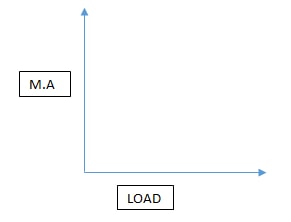
SECTION B :( 45 marks)
(Answer all the questions in this section)
- The figure below shows velocity-time graphs of two objects A and B drawn on same axes
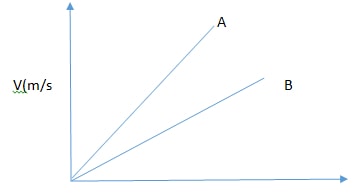
- The two objects are of equal masses. The same size of force is applied against each object. State with a reason which of the two objects stops in a shorter distance. (2 marks)
- An object moving at 30 m/s starts to accelerate at 5m/s2 so that its velocity becomes 50 m/s.
- Find the distance moved during this acceleration (3 mark
- The object is now braked so that it comes to rest in a time of 5 seconds. Find the braking force if its mass was 2700g. (3 marks)
-
- State the law of floatation (1 mark)
- The figure (5) below shows a metallic rod of length 10cm and uniform cross-sectional area 4cm2 suspended from spring balance with 7.5 cm of its length immersed in water. The density of the material is 1.5g/cm3.The density of water is 1 g/cm3.
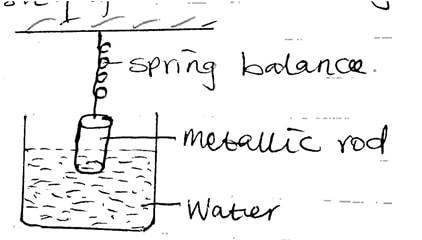
Determine:- The mass of the rod (3marks)
- The upthrust acting on the rod (3marks)
- The reading 0f the spring balance (2marks)
- The reading of the spring balance when the rod is wholly immersed in water (3marks)
-
- State what provides centripetal force for an electron moving round the nucleus (1mark)
- The figure (6) below shows a turntableon which a mass of 50g is placed 10cm from the centre Frictional force between the 50g mass and the turntable is 0.4 N.When the turntable is made to rotate with angular velocity of W rad/sec, the mass starts to slide off.
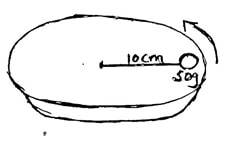
Determine the:- Angular velocity W (3marks)
- Time taken to make one complete revolution (3marks)
- On the figure, draw a path that would be taken by the 50g mass if the turntable suddenly came to stop (1 mark)
-
- An object of the mass 150kg moving at 20m/s collides with a stationary object of mass 90kg.They couple after collision .Determine the :
- Total momentum before collision (2 marks)
- Total momentum after collision (1 mark)
- Their common velocity after collision (2 marks)
- A piece of wire of length 12m is stretched through 2.5cm by a mass of 5 kg. assuming that the wire obeys the Hookes law, what force will stretch it through 4.0 cm.(2marks)
- An object of the mass 150kg moving at 20m/s collides with a stationary object of mass 90kg.They couple after collision .Determine the :
-
- Explain why an air bubble increase in volume as it rises from the bottom of a lake to the surface (2 marks)
- An immersion heater rated 2.5Kw is immersed into a plastic jug containing 21kg of water and switched on for four minutes .Determine:
- The quantity of heat gained by water (2 marks)
- The temperature change for water.(specific heat capacity of water=4.2×103Jkg-1k-1
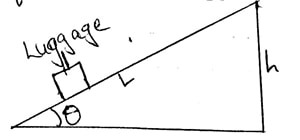
- The figure (7) below shows an inclined plane used to load heavy luggage’s onto a lorry. The length of the plane is L metres and the height is h metres
Show that the velocity ratio is given by 1/ sin Θ

MARKING SCHEME
- Measured diameter = 0.30
0.03
0.27 mm√1
- As the sucker sticks to the clean surface the air in it goes outside cheating a partial vacuum in it, greater atmospheric pressure acts on the sucker from outside.√1 (1mrk)
- Closely wrap the thread 10 times around a cylinder.√1
- use the Meter rule to measure the beginning and the end√1
- Repeat three times and get the average length i.e the circumference√1
- Use the formulae C/π= D√1 to find the diameter (4mks)
- Gases have larger intermolecular distance√1
- - Constriction√
- Narrow bore√
- High temperature range√ (3 mks )
-
- Decreases / reduces √1
- Increases√1
-
- increase their absorbing power √1
- Increase the surface area of exposure√1
- Copper is a good conductor of heat √1 (5mks)
- Prevent heat loss to the surrounding/retain heat in the water√1
- Allow the rays of light inside√1
-
- Product of force and perpendicular distance between the pivot and line of action of the force.√1
- Clockwise moments =Anticlockwise moments or F1d1= F2d2√1
0.5 x 0.3 = W X 0.2√1
W= 0.75N√1 without units ½
- - Luggage compartment in buses are in the lower parts
- Racing cars have low cog and wide wheel base
- Bunsen burner has wide heavy base.
- Chairs /stools/tripods have three or more legs inclined outwards.
- Acrobats . Any two 1 mk each ( 2mks) - Can be trapped and cause accident /fall√1
- Can catch fire√1 (2mks)
- Rate of volume = aV√1
= 4m/s √ 1
SECTION B
-
- B√1
- Has a lower speed √1 (2 mks) - v2 = u2 +29S √1
502 =302+(2x5x5) √1
S= 160m √1 (3 mks) - F = ma√
F =2.7 X -50/15 √1
F =9N √
- v2 = u2 +29S √1
- B√1
-
- A floating object displaces its own weight of the fluid of the fluid in which it floats√1
- ʃ =M/V or M = ʃXV √
M= 1.5 ×4×10
M =60g or 0.06 kg√1 (3mks) - U = ʃ v g
U=1000×(4×7.5)/1000000×10√1
= 0.3N √ - W object - U √
0.6 – 0.3
0.3 N - U = ʃvg
= 1000×40/100000×10
= 0.4N√ 1
W-U
0.6-0.4
0.2N√ 1 (3mks)
- ʃ =M/V or M = ʃXV √
-
- attractive forces between the nucleus and electrons.
-
- F= mw2 1 w =√(F/mr)
=√(0.4/(0.05×0.1) √1
= 8.944mrad/sec √ with/without 1 units - T = 2π/W
T= 2π/8.944
= 0.7024
= 0.705 - A tangent with an arrow
- F= mw2 1 w =√(F/mr)
-
-
- m1v1 +m2+u2√
(150×20)+90×0
3000kgm/s√ 1 - (150+90) √ 1
240vkgm/s √ 1
3000 = 240√
v =12.5 m/s√ 1 (2mks)
- m1v1 +m2+u2√
- F=ke
50 = K × 0.025
K = 2000
OR
F= 50/0.025×4/100
=80N
-
-
- AS it rises pressure decreases √ thus volume of the bubble increases.√
- AS it rises pressure decreases √ thus volume of the bubble increases.√
Download PHYSICS PAPER 1 - KAPSABET BOYS 2019 TRIAL MOCK EXAMINATION.
Tap Here to Download for 50/-
Get on WhatsApp for 50/-
Why download?
- ✔ To read offline at any time.
- ✔ To Print at your convenience
- ✔ Share Easily with Friends / Students


